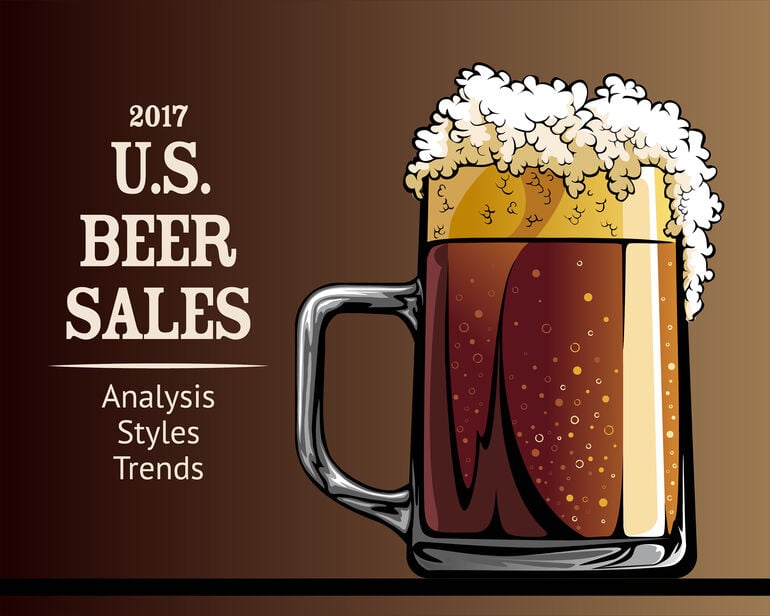Start 14-Day Trial Subscription
*No credit card required

2017 Consumer Beer Sales Analysis
Shifting gears, let’s take a look at styles that fared well – and those that did not – within the Craft category of total beer sales. In general, these shifts are subject to greater fluctuation, as sales from just a few brands can have a large influence on a category.
Aside from IPAs, Golden Ales had a good year, increasing dollar sales by about 39 percent for a total of about $140 million. Stouts grew a hearty 12 percent, adding up to about $70 million in sales, and the “Other Pale Lagers” category grew by more than 25 percent, totaling about $75 million in sales for 2017.
Conversely, Amber Ale had a rough year, dropping 9.3 percent and losing about $14 million in dollar sales. Amber Lager followed suit, dropping about 6 percent and declining in dollar sales by about $8 million. Most other styles remained relatively stagnant.
Zooming out to consider entire beer categories and segments, Cider saw a 3 percent decline in sales, accounting for a dollar sales loss of more than $12.5 million. Similarly, the Flavored Malt Beverages category dropped by 3.5 percent for a total loss of about $77 million. The latter category is one subject to high rates of fluctuation due to more trend-based sales, often propelled through marketing pushes. For instance, Small Town Brewery’s Not Your Father’s Root Beer sales are down over 60 percent from 2016, and dollar sales have plummeted by $50 million. These losses are compounded by rapid market saturation, as these trends bloom quickly, and hot sales are quickly dispersed among multiple channels. AB InBev’s copycat Best Damn Root Beer sales are also down 60 percent.
For AB, sales of both Bud Light and Budweiser dropped more than 5 percent, while its Michelob Ultra performed admirably, seeing an increase of 23.6 percent and bringing total sales to $1.6 billion. Bud Light still remains the top-selling beer in the U.S., clocking in at $5.6 billion in dollar sales.
Across its entire portfolio, AB InBev’s sales dropped by 1.2 percent ($187 million), for a total of $14.9 billion, while the MillerCoors portfolio posted a decline of 1.4 percent, bringing total sales down to $7.7 billion.
Though a distant competitor in dollar share, Pabst Brewing Company’s portfolio of beers also had a rough year in 2017, with dollar sales decreasing 9 percent, down to $564 million.
If awards were to be given out, Constellation Brands would take home the 2017 Beer Sales Title. The company was the only manufacturer to see double-digit growth in dollar sales (14.1 percent) and volume sales (12.5 percent), clocking in at just under $4 billion in total sales. Its portfolio includes top imports such as Modelo and Corona, along with acquisitions Ballast Point and Funky Buddha.
Honorable mentions would also be given out to many of the larger but not-quite-conglomerate-level brewing operations, which saw almost uniform growth in dollar sales. Bell’s Brewery Inc., Stone Brewing Co., Sweetwater Brewing Company LLC, Firestone Walker Brewing Co., Dogfish Head Craft Brewery, New Glarus Brewing Co. and Artisanal Brewing Ventures all saw between 10 and 20 percent growth in 2017.
Founders Brewing Co. also gets a trophy for increasing total dollar sales by 42.6 percent, for a total of around $79 million. These numbers are largely attributable to the phenomenal growth of All Day IPA, which accounted for more than half of Founders’ total sales.
The unwritten tale of the tape here is the effect that craft beer has had on the perceived value of domestic beer, and vicariously, imports. As consumer interest shifts away from the standard macros of old, we find a new battleground based not so much on what is being offered, as any emergent trend will rapidly be duplicated and saturated, but how it is being delivered. Distribution infrastructure and (to a lesser degree) marketing will dictate sales. And it doesn’t hurt to be backed by a multi-billion-dollar empire.
Booms and busts are an inevitable element of any large industry. Though 2017 saw many stalwart brands decline in sales or remain stagnant, it’s important to factor in that overall, beer is thriving. The bubble isn’t bursting so much as being blown about by the winds of big business and consumerism, and taking a new shape.



